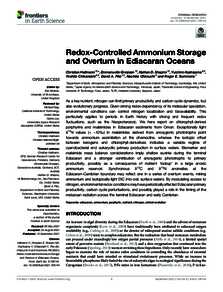Document
Redox-controlled ammonium storage and overturn in ediacaran oceans.
Identifier
DOI: 10.3389/feart.2021.706144
Source
Frontiers in Earth Science. v. 9, 706144
Contributors
Grosjean, Emmanuelle., Author
Shapiro, Nathan D., Author
Kashiyama, Yuichiro., Author
Chikaraishi, Yoshito., Author
Fike, David A., Author
Ohkouchi, Naohiko., Author
Summons, Roger E., Author
Country
Switzerland
Publisher
Frontiers Media S.A.
Gregorian
2021-09-10
Language
English
English abstract
As a key nutrient, nitrogen can limit primary productivity and carbon cycle dynamics, but also evolutionary progress. Given strong redox-dependency of its molecular speciation, environmental conditions can control nitrogen localization and bioavailability. This particularly applies to periods in Earth history with strong and frequent redox fluctuations, such as the Neoproterozoic. We here report on chlorophyll-derived porphyrins and maleimides in Ediacaran sediments from Oman. Exceptionally light δ15N values ( –10‰) in maleimides derived from anoxygenic phototrophs point towards ammonium assimilation at the chemocline, whereas the isotopic offset between kerogens and chlorophyll-derivatives indicates a variable regime of cyanobacterial and eukaryotic primary production in surface waters. Biomarker and maleimide mass balance considerations imply shallow euxinia during the terminal Ediacaran and a stronger contribution of anoxygenic phototrophs to primary productivity, possibly as a consequence of nutrient ‘lockup’ in a large anoxic ammonium reservoir. Synchronous δ13C and δ15N anomalies at the Ediacaran–Cambrian boundary may reflect one in a series of overturn events, mixing ammonium and isotopically-light DIC into oxic surface waters. By modulating access to nitrogen, environmental redox conditions may have periodically affected Ediacaran primary productivity, carbon cycle perturbations, and possibly played a role in the timing of the metazoan radiation across the terminal Ediacaran and early Cambrian.
ISSN
2296-6463
Category
Journal articles


